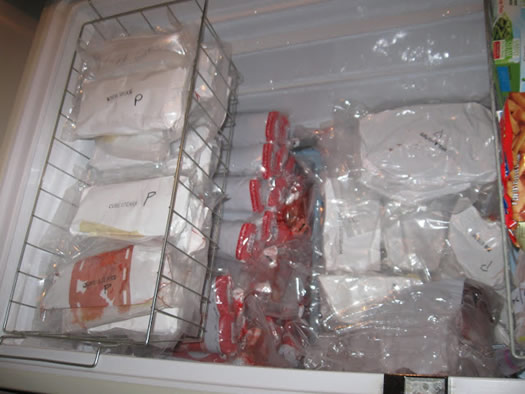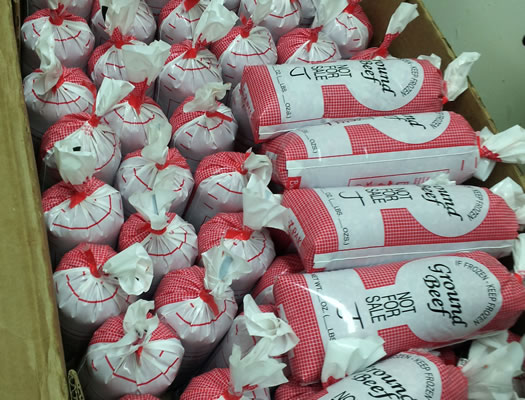How raising steer has changed the way I eat

Back in the 70s and early 80s, my father-in-law raised animals. Steers, a few pigs, turkeys, and the freezer often had some hunted venison. Most of that had stopped by the time I started hanging around in the early 90s.
In December of 2003, the first case of mad cow disease was discovered in the US. A few weeks later at a New Year's party, my father-in-law asked, "If I did cows again, would you want in?"
Being a little too into all things food -- and a bit drunk -- I was game. And I'm glad I was. Because there is no doubt the experience has changed the way I cook and eat.
My brother-in-law took up the offer, too. However, we both entered this verbal agreement without talking to our wives. They were not pleased with us. Having grown up spending all day doing projects they were told would only take "half an hour," they were much more familiar with my father-in-law's projects than we were.

So, with some justifiably angry spouses (it's OK, no divorces were caused by this endeavor), we set out to fence in a five-acre pasture. The fence and corral took a long time to build. Locust trees were cut into posts, bark was stripped, holes dug, and poles were set dividing the five or so acres into three pastures. The time commitment didn't end with the fence. My father-in-law handles the day-to-day work, but there is always something to be done -- weed whacking the fence on Father's Day has become a tradition.
The butchering
At slaughter time, two steers get split between four families. Each family gets their side of beef cut to their specifications.
I don't think this is typical with our butcher, but we help with the meat processing. Most people just give him a list of cuts and then come pick up their beef already wrapped in freezer paper. These people miss watching a butcher showcase decades of experience. Everything -- from removing the hide and gutting the steer to breaking down the sides of beef -- is done to in a way to minimize the amount of work needed. And his knife skills are unbelievable. He can just walk up to a slab of beef (something Rocky would have hit), and go slice, slice, slice -- and off comes a big piece of beef for him to break down. There is never wasted movement. It's borderline graceful.
It seems like butchers are starting to make a comeback. Our guy makes a distinction between butchers and meat cutters. A butcher can take an animal, break it down, and maximize its use. A meat cutter opens cryovac-packed pieces of beef and makes steaks.
Maybe it's my imagination, but I believe our butcher likes having us in his shop. I ask a lot questions, he tells stories, and he enjoys giving my father-in-law a hard time. I think we're a nice break in an otherwise lonely routine.
The total cost of the meat ends up being about $2.50 per pound of hanging weight. That includes buying the steer at 8-12 months old, raising them to 24 months, and butchering them. The fee for the slaughter and dry aging is the hides. The butcher sells them. I think he gets around $125 to $150 for each hide.
All that meat

There is a lot of meat in a side of beef. The hanging weight of the steer -- the meat with all the fat and bones that goes into a cooler for two weeks to dry age prior to cutting -- is in the area of 800 pounds. So, a side is about 400 pounds to start. From that we usually end up with about 120 pounds of ground beef, and another 100 pounds of various cuts. There's a lot of bone and fat in there. And there's offal, too, which we don't use as much as we should. (I'm the only one willing to try any of it and there is just way too much for me to eat.)
Over time, the way I've chosen to have our side of beef cut has changed. A huge rib roast for an event is kind of like saving that bottle of wine for a special occasion that never comes. So I stopped doing it and now lean towards steaks over roasts. And not all of the meat is cuts you would seek out in a supermarket. I've been trying sous vide -- in which the meat is vacuum bagged and cooked in a water bath -- to dial in a good system for some of the less tender cuts. I've also made summer sausage and beef kielbasa out of some of the cuts that will never get tender. The bottom line is that if you only like filet or strip steak, a side of beef is not for you.

And then there's the ground beef. The butcher packs it into 1.4-pound sleeves, and one of those makes four good-sized burgers. We also use it for meatloaf, pasta sauce, tacos/nachos/quesadillas, and sometimes meatballs. You need to pace yourself throughout the year or else there will be a beef-eating binge prior to the next slaughter.
I don't often eat beef that isn't our beef -- partially because our beef supplies my diet with plenty of red meat, but mainly because I feel our beef is significantly better than just about anything I could buy.
This was an animal
We are killing an animal for food. There is no way to dull or sugarcoat that fact. And there have been times I've been conflicted about that. I'd say the toughest was when my oldest daughter was at the age where you start to put together that chicken is actually a chicken. On one of the packing days she looked at me with big, wide eyes and asked, "Daddy, did you kill a cow today?" I explained that the cow was killed a few weeks ago and that day we put all the meat in the freezer.
I think I might actually eat less meat now than when I started this project. I waste less food and have a higher respect for ingredients, especially meat. I pay more attention to my food sources and how animals are treated. I also continue to learn and try to use as much of the animal as possible. This has become very important to me.

On the other hand, you aren't going to find a steer that had a better year. It can go wherever it wants, has all the water, grass, and hay it can eat, with the occasional grain dessert. The grain might not be the healthiest thing for them, but they are kind of trained -- if my father-in-law walks out to the barn yelling, "C'mon!" they come trotting right to the barn. If one ever got outside the fence, a few calls of "C'mon!" and they would be back. It's a nice piece of mind. I guess what I'm getting at is that if you are going to eat beef, you are not going to find beef that was raised more humanely than this.
But back to the first hand: Does providing an animal a good life give you the right to kill it and eat it? As of today, my answer is yes. Which has to have some irony because both of my parents were vegetarians for as long as I can remember. My father passed away a few years ago, but my mother still eats essentially a vegan diet.
Maybe it's rebellion. The son of two vegetarians helps raise beef.
Jon writes about food and other stuff at Jon in Albany. (He also makes excellent pizza.)
More from Following Food week
+ Drawing: Capital District Food Tour tickets + Honest Weight gift card: If you had to pick one food item to represent the Capital Region, what would it be?
+ Defining an upstate cuisine
Hi there. Comments have been closed for this item. Still have something to say? Contact us.

Comments
Two questions:
1. Who is your butcher?
2. Do you want help with the offal? I can trade bread.
... said Burnt My Fingers on Nov 18, 2015 at 6:31 PM | link
Our butcher is retired but still does some work for his old customers. I doubt he'd want me to put his contact information online.
I'd love some help with the offal. I'll get in touch with you closer to the slaughter date.
... said Jon in Albany on Nov 19, 2015 at 7:49 PM | link